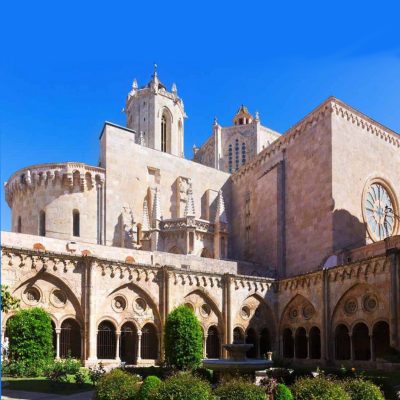HOME Exhibitions and Instalations Diocesan Museum of Tarragona Exhibition, 2023
Tarragona Diocesan Museum
“From Maternity to Nativity, 800 years since the first crib” exhibition
22.11 – 21.12.2023
Tarragona
80-cm-high in Santa Tecla marble

Representing 20th and 21st century sacred art, Guido Dettoni della Grazia‘s sculpture MARIA was included in the exhibition “Natus est in Bethlehem. a journey through the 800 years of the first nativity scene“, on the occasion of the 800th anniversary of the first crib that Saint Francis of Assisi placed in a small grotto in the Italian town of Greccio during the Christmas Eve Mass of 1.223, organised by the Archdiocese of Tarragona, through the Diocesan Cultural Delegation, which took place in December 2023 at the Centre Tarraconense El Seminari.
It could be said that this enlargement, 80 centimeters high, is the sculpture MARIA of Tarragona by Guido Dettoni. It is sculpted in Santa Tecla marble (patron saint of Tarragona) from the Santa Tecla quarry, now closed, next to the Loreto Hermitage in Tarragona. The marble was prepared for the artist sculpting by the Marbres Castelló, factory dedicated to working marbles and granites, also based in Tarragona.
The sculpture was made for the “MARIA mare de deu” exhibition held in the Old Refectory of the Canons of Tarragona Cathedral in 1999, and later, donated by the company Vodafone (formerly Airtel) became part of the collection of the Diocesan Museum of this ancient Roman city.
The exhibition “From motherhood to the crib, a journey through the 800 years of the first nativity scene” was made up of a series of thematic and chronological showcases that made up a short journey through the history of art. The exhibition began with a facsimile edition of the Codex Sinaiticus, the oldest surviving Bible, and continued with a first collection of pieces related to motherhood; like its representation from Nigeria, from the collection of Jesús Arjona, used in rituals to honour women; some Marian images such as the Virgin of Valldossera, a majolica from the 16th century, an oil on copper of the Virgin of Help, and MARIA by Guido Dettoni, an abstract Virgin representing the culture of the 20th and 21st centuries.
After this first space dedicated to motherhood, the itinerary moved on to the theme of the Nativity, starting with a reproduction of an early Christian sarcophagus from the 4th century, which contains the oldest representation of the Nativity, with Mary and the Child, the Wise Men, the ox and the mule and the shepherd. There is also a facsimile edition of the Ripoll Bible from the 11th century, an oil on copper from Casa Balcells, a peace holder with the Nativity from the Priory Church of Saint Peter Apostle in Reus and various illustrated Bibles from the XIX century. Finally, the exhibition route culminates in the nativity scene from Casa Canals, with figures from 1800, which are kept in the Diocesan Museum of Tarragona, and which the Tarragona nativity scene maker Quim Nolla has placed in the context of a large nativity scene in which we find an exact reproduction of the chapel of Saint Paul inside El Seminari.

Image of the Mother of God, cathedral (20th century)
Text of the placard of the work MARIA in the exhibition
The image of Mary can be presented in a “pure” formal language.
It lacks the physical concretion that would affect the final essence of what it is supposed to represent. An interesting marble sculpture representing the Mother of God (1999) was conceived from a concept of figurative abstraction (MDT-D-0219).
It is the work MARIA by Guido Dettoni della Grazia. The sculpture is supported by a limestone column bearing the inscription of a poem by Carles Duarte, which reads: “You are the mother, the origin, the life where God will take shelter. The hands are a haven where I learn to invoke you». Guido Dettoni understands MARIA as a polyhedral icon that represents Mary, the mother of Jesus from the Gospel, but also Maryam from Sura 19 of Alcorà, Shakti from Hinduism, Kuan-yin from the Chinese tradition, and the image of femininity from many cultures of the world.
For the Christian observer, the image of Mary by Guido Dettoni, from different cultural and spiritual codes, is open to multiple readings: Does a flame burn to enlighten humanity? A Mother protecting her child with her mantle? An undertaking of the divine dynamics that acts on matter to transform it into spirit?… Perhaps the form that the matter is given here is an open way to discover the essential attributes of the Mother of God. In short, this is the final function of sacred art in all times: a liturgical element, a catechetical expression, but above all a link of communication between faith and prayer.






